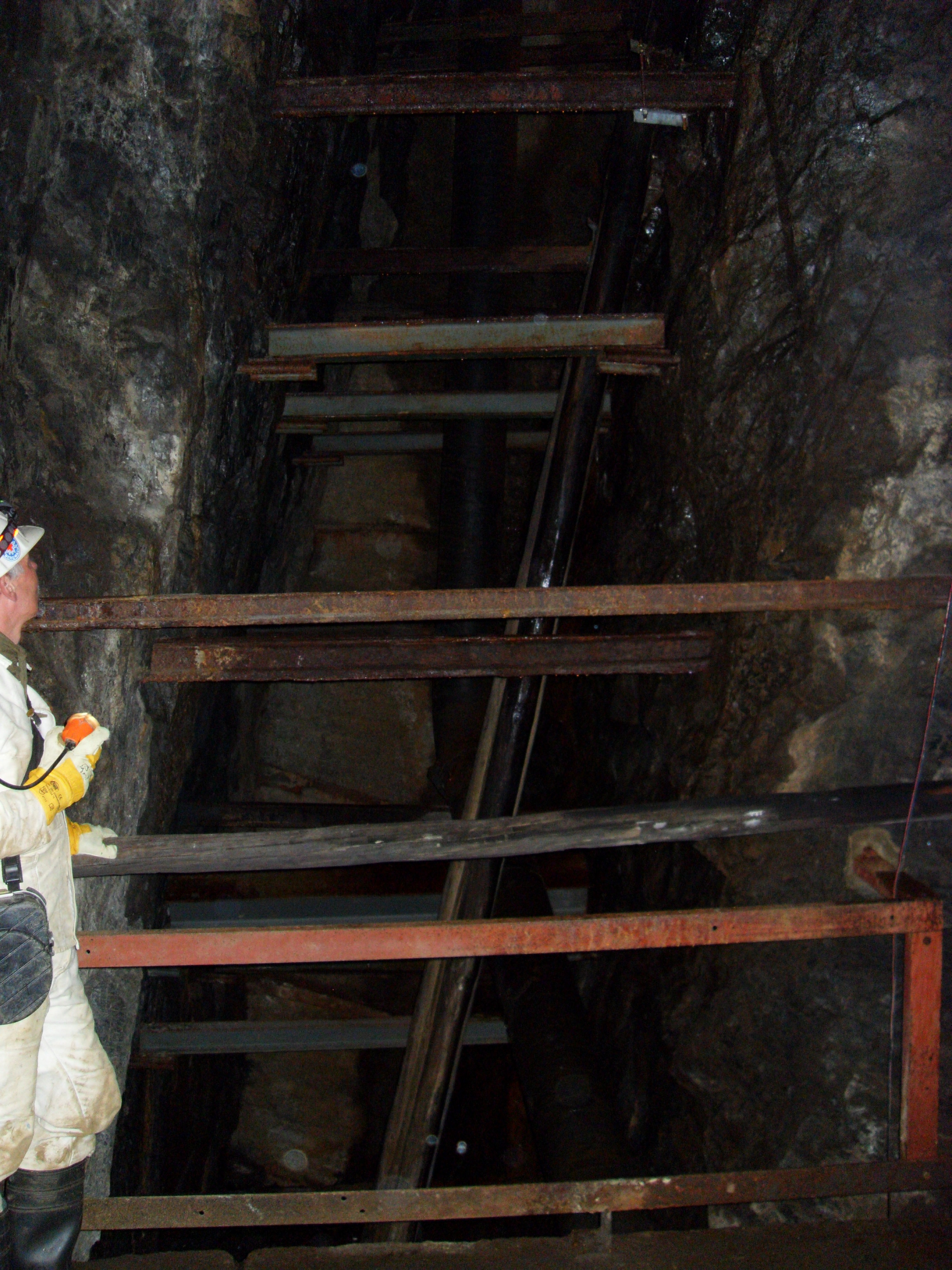|
Samson Pit
The Samson Pit or Samson Mine (german: Grube Samson) is an historic silver mine in Sankt Andreasberg in the Upper Harz region of central Germany.''Samson Mine'' at www.mindat.org. Retrieved on 8 May 2010. The pit has one of the oldest man engines in the world still working and it can be seen in operation during guided tours.''West Harz Places – St. Andreasberg'' at www.harzmagic-info.co. Retrieved on 8 May 2010. The man engine, installed in the Samson Pit in 1837, used to be driven by the |
Man Engine
A man engine is a mechanism of reciprocating ladders and stationary platforms installed in Mining, mines to assist the miners' journeys to and from the working levels. It was invented in Germany in the 19th century and was a prominent feature of tin and copper mines in Cornwall until the beginning of the twentieth century. Operation In the Cornish examples the motive power was provided by waterwheels, or one of the mine's steam engines. The steam engine or water wheel would be linked to a series of beams – known as "rods" – fastened together and reaching to the bottom of the mineshaft. These were arranged to offer a reciprocating motion of, typically, twelve to fifteen feet (three to five metres). Small foot platforms were attached to the rods at the same distance apart as the engine stroke and fixed platforms ("sollars") were built onto the shaft walls, spaced to coincide with the top and bottom positions of each of the moving platforms. The moving platforms were often sma ... [...More Info...] [...Related Items...] OR: [Wikipedia] [Google] [Baidu] |
American Society Of Mechanical Engineers
The American Society of Mechanical Engineers (ASME) is an American professional association that, in its own words, "promotes the art, science, and practice of multidisciplinary engineering and allied sciences around the globe" via "continuing education, training and professional development, codes and standards, research, conferences and publications, government relations, and other forms of outreach." ASME is thus an engineering society, a standards organization, a research and development organization, an advocacy organization, a provider of training and education, and a nonprofit organization. Founded as an engineering society focused on mechanical engineering in North America, ASME is today multidisciplinary and global. ASME has over 85,000 members in more than 135 countries worldwide. ASME was founded in 1880 by Alexander Lyman Holley, Henry Rossiter Worthington, John Edison Sweet and Matthias N. Forney in response to numerous steam boiler pressure vessel failures. Kno ... [...More Info...] [...Related Items...] OR: [Wikipedia] [Google] [Baidu] |
Horse Gin
A horse mill is a mill, sometimes used in conjunction with a watermill or windmill, that uses a horse engine as the power source. Any milling process can be powered in this way, but the most frequent use of animal power in horse mills was for grinding grain and pumping water. Other animal engines for powering mills are powered by dogs, donkeys, oxen or camels. Treadwheels are engines powered by humans. History The donkey or horse-driven rotary mill was a 4th-century BC Carthaginian invention, with possible origins in Carthaginian Sardinia. Two Carthaginian animal-powered millstones built using red lava from Carthaginian-controlled Mulargia in Sardinia were found in a 375–350 BC shipwreck near Mallorca. The mill spread to Sicily, arriving in Italy in the 3rd century BC. The Carthaginians used hand-powered rotary mills as early as the 6th century BC, and the use of the rotary mill in Spanish lead and silver mines may have contributed to the rise of the larger, animal-powered mill. ... [...More Info...] [...Related Items...] OR: [Wikipedia] [Google] [Baidu] |
Harzer Roller
Harz Roller (german: link=no, Harzer Roller ) is the name of a breed of domestic canary bred in the Upper Harz mountains of Germany. The birds were bred in the Upper Harz between Lautenthal and Sankt Andreasberg in the middle of the 19th century and achieved European-wide fame. Since 2001 there has been a Harz Roller Museum in Sankt Andreasberg. By patient breeding, a breed of canary was able to be produced that had a pleasant, melodious song, full of variety and delivered with an apparently closed beak. Different types of canaries can breed with each other, especially including the Harz Roller and the Spanish Timbrado. Miner's canary The breeding and sale of this popular breed of canary was an important secondary occupation for mining people, as was the making of cages for the birds. In the second half of the 19th century, the breeding and sale of these canaries boomed. In contrast to widespread legend, the birds were ''not'' used in the mines to indicate the presence o ... [...More Info...] [...Related Items...] OR: [Wikipedia] [Google] [Baidu] |
Samsonite (mineral)
Samsonite is a silver manganese antimony sulfosalt mineral with formula Ag4 Mn Sb2 S6. It crystallizes in the monoclinic crystal system with a typical slender radiating prismatic habit. It is metallic black to steel black with no cleavage and a brittle to conchoidal fracture. In thin fragments it appears reddish brown in transmitted light and also leaves a red streak. It is soft, Mohs hardness of 2.5, and has a specific gravity of 5.51. It was first named in 1910 after an occurrence in the Samson Vein of the Sankt Andreasberg silver mines, Harz Mountains, Germany. See also * Classification of minerals * List of minerals References *Palache ''(Previously, this page expanded into a family history–now in separate entry: q.v. "Pallache family.")'' The Pallache (see Pallache family for many spellings of name) are a Sephardic Jewish family who originated on the Iberian Peninsula, sprea ..., C., H. Berman, and C. Frondel (1944) Dana's system of mineralogy, (7th edition), v. I ... [...More Info...] [...Related Items...] OR: [Wikipedia] [Google] [Baidu] |
Chlorargyrite
Chlorargyrite is the mineral form of silver chloride (AgCl). Chlorargyrite occurs as a secondary mineral phase in the oxidation of silver mineral deposits. It crystallizes in the isometric - hexoctahedral crystal class. Typically massive to columnar in occurrence it also has been found as colorless to variably yellow cubic crystals. The color changes to brown or purple on exposure to light. It is quite soft with a Mohs hardness of 1 to 2 and dense with a specific gravity of 5.55. It is also known as cerargyrite and, when weathered by desert air, as horn silver. Bromian chlorargyrite (or embolite) is also common. Chlorargyrite is water-insoluble. It occurs associated with native silver, cerussite, iodargyrite, atacamite, malachite, jarosite and various iron–manganese oxides. It was first described in 1875 for occurrences in the Broken Hill district, New South Wales, Australia. The rich Bridal Chamber deposit at Lake Valley, Sierra County, New Mexico was almost pure chorargyrit ... [...More Info...] [...Related Items...] OR: [Wikipedia] [Google] [Baidu] |
Antimony
Antimony is a chemical element with the symbol Sb (from la, stibium) and atomic number 51. A lustrous gray metalloid, it is found in nature mainly as the sulfide mineral stibnite (Sb2S3). Antimony compounds have been known since ancient times and were powdered for use as medicine and cosmetics, often known by the Arabic name kohl. The earliest known description of the metal in the West was written in 1540 by Vannoccio Biringuccio. China is the largest producer of antimony and its compounds, with most production coming from the Xikuangshan Mine in Hunan. The industrial methods for refining antimony from stibnite are roasting followed by reduction with carbon, or direct reduction of stibnite with iron. The largest applications for metallic antimony are in alloys with lead and tin, which have improved properties for solders, bullets, and plain bearings. It improves the rigidity of lead-alloy plates in lead–acid batteries. Antimony trioxide is a prominent additive for halo ... [...More Info...] [...Related Items...] OR: [Wikipedia] [Google] [Baidu] |
Breithauptite
Breithauptite is a nickel antimonide mineral with the simple formula NiSb. Breithauptite is a metallic opaque copper-red mineral crystallizing in the hexagonal - dihexagonal dipyramidal crystal system. It is typically massive to reniform in habit, but is observed as tabular crystals. It has a Mohs hardness of 3.5 to 4 and a specific gravity of 8.23. It occurs in hydrothermal calcite veins associated with cobalt–nickel–silver ores. It was first described in 1840 from the Harz Mountains, Lower Saxony, Germany and in 1845 for occurrences in the Cobalt and Thunder Bay districts of Ontario, Canada. It was named to honor Saxon mineralogist Johann Friedrich August Breithaupt (1791–1873). See also *List of minerals *List of minerals named after people This is a list of minerals named after people. The chemical composition follows name. A *Abelsonite: C31H32N4Ni – American physicist Philip Hauge Abelson (1913–2004)alfred *Abswurmbachite: Cu2+Mn3+6O8SiO4 – German ... [...More Info...] [...Related Items...] OR: [Wikipedia] [Google] [Baidu] |
Arsenic
Arsenic is a chemical element with the symbol As and atomic number 33. Arsenic occurs in many minerals, usually in combination with sulfur and metals, but also as a pure elemental crystal. Arsenic is a metalloid. It has various allotropes, but only the gray form, which has a metallic appearance, is important to industry. The primary use of arsenic is in alloys of lead (for example, in car batteries and ammunition). Arsenic is a common n-type dopant in semiconductor electronic devices. It is also a component of the III-V compound semiconductor gallium arsenide. Arsenic and its compounds, especially the trioxide, are used in the production of pesticides, treated wood products, herbicides, and insecticides. These applications are declining with the increasing recognition of the toxicity of arsenic and its compounds. A few species of bacteria are able to use arsenic compounds as respiratory metabolites. Trace quantities of arsenic are an essential dietary element in rats, ham ... [...More Info...] [...Related Items...] OR: [Wikipedia] [Google] [Baidu] |


_pg328_AMERICAN_SOCIETY_OF_MECHANICAL_ENGINEERS._12_WEST_31ST_STREET.jpg)


